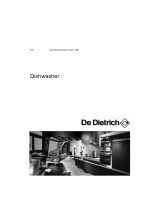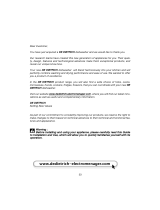34
1/ FOR THE USER’S ATTENTION
EN
Important :
Keep this user’s manual with your
appliance. If the appliance is sold or trans-
ferred to someone else, ensure that the man-
ual is with it. Please take note of these
instructions before installing and using your
appliance. They have been drawn up for your
own and other people’s safety.
• SAFETY INSTRUCTIONS
• Installation
— When you receive your appliance, unpack it
or have it unpacked immediately. Check that it
has not suffered any damage during transport.
Express any reservations in writing on the
delivery note, of which you keep a copy. Never
connect up a damaged machine. If your appli-
ance is damaged, please contact your dealer.
— Before proceeding to connect up your
machine, please refer to the instructions in
your Installation Guide.
— Your dishwasher must be kept disconnected
from the mains supply throughout the whole
of the installation process.
— The electrical connection details on your
appliance’s description plate must comply
with those for the mains supply.
— The socket must still be accessible once
your appliance has been installed.
— Do not alter or attempt to alter the appli-
ance’s characteristics. This could put you at
risk.
— If your installation has to be altered, only
entrust the electrical and plumbing work to a
qualified electrician or plumber respectively.
— Your appliance is designed for normal
domestic use. Do not use it for industrial or
commercial purposes or for any other pur-
pose than that for which it has been designed.
— The dishwasher’s walls must not be pierced
under any circumstances.
• Children’s safety
— This appliance must only be used by adults.
Ensure that children do not touch it and do not
use it as a toy. Ensure that they do not operate
the appliance’s controls.
— Keep young children away from the appli-
ance when it is operating.
— Detergents contain irritant and abrasive sub-
stances. These products can have caustic
effects on the eyes, the mouth or the throat.
They can be extremely dangerous if ingested.
Avoid any contact with the skin and the eyes.
Ensure that the appliance’s detergent contain-
er is empty at the end of the washing cycle.
— Place detergents out of children’s reach and
do not put any detergent in the machine until
just before you start the washing programme.
— The water in your dishwasher is not drinking
water; this is why children must not go near
the appliance when its door is open.
— Do not let your children play or sit on the
door when it is open.
— Once you have unpacked your appliance,
place the packaging out of children’s reach.
— Keep all the packaging materials (e.g. plastic
bags, polystyrene, etc.) out of children’s reach
because they can be dangerous for children:
risk of suffocation.
• Use
— Only use products specially designed for
your dishwasher (water softening salt, deter-
gent and rinsing products).
— As far as possible, avoid opening the dish-
washer’s door when it is operating, and in par-
ticular during the heating phases, because
scalding steam may escape or you may be
splashed with hot water. The machine is fitted
with a safety system that immediately blocks
the dishwasher’s operation if the door is
opened.


























